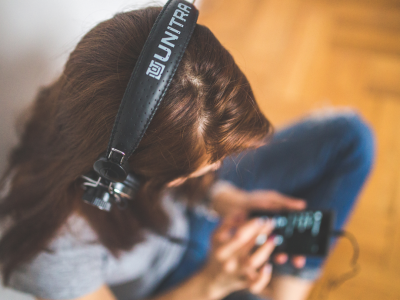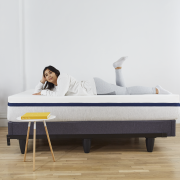Sleeping on one’s side is the most common sleep position in the world and one which most experts recommend. Whether you prefer the right side, or you like sleeping on your left side, you can optimize your sleep style, so you stay cool, comfortable, and asleep throughout the night.
Although sleeping on your side isn’t for everyone, it’s important that you know how to sleep on your side so you can feel safe and comfortable when you roll onto your side in the night. In this article, we’ll go over how to properly sleep on your side and how you can improve your side sleeping for a better night’s sleep.
Different Types of Side Sleepers
There are many ways to sleep on your side. We’ve touched on the various side sleeping positions below so you can find out which sleep style you identify with.
Fetal Position
People who sleep alone often naturally gravitate toward the fetal position. In this position, sleepers curl up into a ball that resembles how a newborn baby sleeps in their crib.
Neutral Position
The neutral position is one that involves the free arm and leg flopping over and sprawling on the bed in a relaxed, easy-going manner.
Pillow Cuddler
Many side sleepers clutch onto a body pillow and hold it close to their body. Some side sleepers insert the bottom of the pillow between their legs for extra structural support.
Common Problems With The Side Sleeping Position
Side sleeping can actually help with conditions like sleep apnea, but it isn’t the ideal position for everyone. Unfortunately, there are some common ailments and health issues that affect side sleepers more than other sleeping styles—check them out below.
Acid Reflux
Like stomach sleepers, sleeping on side can lead to acid reflux, commonly referred to as “heartburn.” When you sleep on your side, digestive acids in your stomach can enter your throat, which causes an unpleasant and distracting burning sensation.
Low Back Pain
Side sleepers who use a poorly-fitted mattress often complain about lower back pain. Choosing the right size mattress can eliminate much of the pain associated with this sleeping style.
Shoulder Pain
Side sleeping places a lot of pressure on your hips and shoulders. Selecting a soft, plush mattress can eliminate pressure points in your shoulder joints when learning how to sleep on side.
Tips For Improving Side Sleeping
Side sleepers rejoice—there are plenty of techniques and tricks that you can use to improve your sleep and reduce the discomfort of side sleeping. We’ve listed them below.
Find The Right Mattress
This one’s obvious. If you’re a side sleeper, it’s crucial that you take the time to find the right mattress for your body type and sleeping style. Otherwise, you’re bound to wake up throughout the night and feel the effects the next morning. If you’re wondering what mattress is right for you, try the Helix Sleep quiz to find a personalized fit.
Use A Support Pillow
It helps to snuggle a pillow if you find you’re experiencing aches and pains in your sleep. Try placing a body pillow between your legs to keep your hips properly aligned.
Switch Sides
We’re often asked, “what is the best side to sleep on?” The truth is that there is no ideal side to sleep on, but if you’re a right-side sleeper you might find relief by switching to your left. Sleeping on your left side removes pressure from your lungs and heart and supports respiration.
Don’t Skimp On The Pillows
Feel free to load up on your bed pillows. Extra pillows can be placed between your legs and joints to relieve pressure points.
Alternative Positions Side Sleepers Should Try
Neck Pillow Support
Sleepers who experience neck pain should try ergonomic pillows that your support the vertebrae in the neck. These pillows angle your neck in a comfortable position to alleviate stress.
Between-the-Leg Pillow
Pregnant women and those who have achy hips or sore joints in your lower body, consider picking up a long pillow to place between your legs. This pillow keeps your hips in a neutral position and leads to a more comfortable night’s sleep.
Lumbar Pillow Support
Placing a stiff pillow behind your lower back (called the “lumbar”) can help prop your body in an upright position and prevent you from falling over in your sleep. A wedge pillow can also help in these scenarios.
Upright Neck Pillow
If you regularly wake up with a stiff neck, try using a larger and firmer pillow under your head. The goal is to keep your neck and spine in a straight line without sloping—a stiffer pillow can help you achieve that. Placing a pillow under your neck is also a great idea for sleepers who tend to snore and annoy their partner.
Side Sleeper Questions and Answers
Which Mattress Type Is Best For Side Sleepers?
Ideally, a side sleeping should select a medium-density mattress that is neither too firm nor too soft. You want your mattress to be soft enough to prevent shoulder and hip pain, but firm enough to keep your spine aligned with a natural curve. Therefore, side sleepers should opt for a hybrid-style mattress made of composite materials.
Should Side Sleepers Have a Firm Mattress?
No, side sleepers should refrain from sleeping on surfaces that are firm or dense. Instead, side sleepers are better off selecting a medium-soft mattress that cushions your hips, shoulders, and neck. However, you also don’t want to choose a mattress that’s so soft that it causes your hips to sink too far into the material.
What Kind of Pillow Should Side Sleepers Use?
When choosing what side to sleep on, consider placing a pillow between your legs or lodging one behind your back. Take turns shifting from one side of your body to the other. This way, you can discover which side feels more natural and comfortable. You should sleep on whichever side your body naturally prefers.
However, you can’t support your back or hips unless you choose a firm enough pillow. Otherwise, your body will sink into the pillow and, in doing so, mess up your body’s natural alignment.
Do Your Research
There’s no way of knowing what mattress and pillow type is best for you unless you do your research. To find out what pillow and mattress best suits your sleep style, body type, and preferences, take the Helix Sleep Quiz today and find out how you can cater to your body’s needs.















